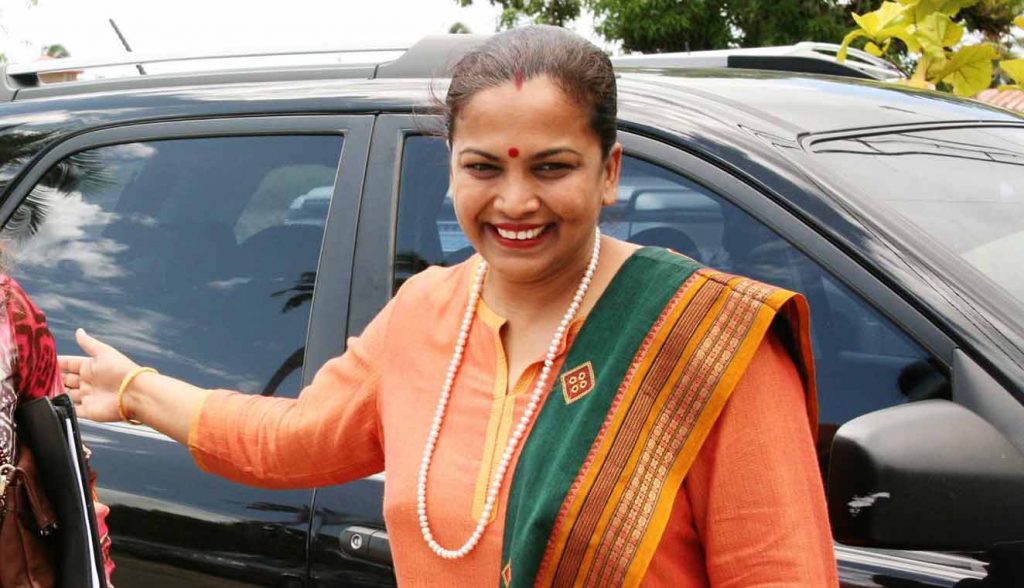‘Hindu dharma declares that the entire creation is a manifestation of the Supreme and does not assign a superior role for human beings over nature.”
These were the opening remarks of Geeta Vahini, President of the HPK. She was speaking on “The Hindu View of the Environment” on ICDN Wednesday Night Zoom (18/11/20). The theme was “Climate Change and its Impact on Human Society.” The other speaker was the Acting Climatologist of Trinidad and Tobago, Kaidar Kissoon.
Geeta Vahain said that Hindu dharma passionately encourages caring for the environment and that unlike other theologies that give man free reign and dominion over the environment, this is not so in Hindu dharma where man is enjoined to protect the environment and all its creatures.
“The shastras or scriptures are unambiguous on man’s role to protect the environment and this is embedded in the many Hindu rituals and ceremonies,” said Geeta Vahini, a graduate of the Suddhananda Ashram of Chennai, India where she pursued studies in Hindu Theology.
Geetaji quoted from the Ramayan and Bhagavad Gita to support her point of view. “‘Siya Ram mai sab jag jaani’- see the entire universe as a manifestation of the divine,” is a popular verse taken from the Ramayan. Geetaji also quoted from the Bhagavad Gita where Sri Krishna said: “I am the unseen thread that holds the universe together like the thread that holds the flowers in a garland.”
He pointed to three rituals that were integral to the daily life of a Hindu: Sudhana, Puja and Havan. She lamented that Sudhana has been lost over time. It is a prayer that is said even before getting out of bed: “O’ Mother Earth whose garment and ocean and whose bosom is the mountain, O’ Consort of Bhagavan Vishnu…salutations to you, forgive me as I am about to put my feet on your sacred body to touch you.”
Hindu theology places much emphasis on the protection of the environment. This is revealed in the Bhoomi Sukta, a prayer of 63 verses in the Atharva Veda on man’s relationship with the earth. Geetaji said that the opening verse talks about how the human being should approach the environment – “One should approach the earth cautiously all the living being and inanimate things.”
Pooja ritual is an aspect of Hindu worship that has survived in the Caribbean. Geetaji said that the bedi represents the entire earth and most importantly that “no puja is complete without water and plant.” She continued: “Each deity is associated with an animal and plant.”
Haavan or the burning of grains and herbs in ghee has a purifying potency to rid the environment of bacteria and viruses. In this era of COVID 19, it is certainly opportunistic for Hindus to intensify their commitment to these rituals.
Ganga Dhaara is a water ritual that is sponsored annually by the Hindu Prachaar Kendra that coincides with the official start of the rainy season. “Associated with Ganga dhaara is the Mundan Sanskar or the fist shaving of the heads of the child. “The Mundan Sanskara is very important because hair takes a long time to grow and its disposal must not be carried out whimsically,” said GeetaJi.
Kaidar Kissoon said that climate change is undeniably here with us and is seen with the shift in rainfall pattern and an increase in temperature in our country and around. He added that “climate change is a cycle and it is influenced by the activities of plants and animals.”
The holder of an MSc in Climate and Management, Kissoon said industrialization has contributed to the rise of carbon dioxide in the atmospheres and pointed out that carbon emission is driven by consumption. “The high levels of pollution in China and India and other third world countries are driven by our demand for their goods,” said the climatologist.
“But there are four R rules that can help us to fight climate change: reuse, recycle, refuse and reduce,” Kissoon said. You may be wondering what is “refuse.” It is to refuse something that you can live without and an example he gave was a drinking straw.
Dr. Primnath Gooptar who was in the audience lamented the high level of wastage that is seen after puja is conducted. For example, he questioned the amount of milk used for offering. Gitaji agreed that if milk was not available, water can be offered.
The value of cow in the Hindu environment was also raised. “The cow is a critical aspect of Hindu life. It connects us with the land. The cow is a source of livelihood providing us with milk, fertilizer and fuel. In the ashram where I studied, bio-fuel was used for lighting and cooking,” said Geetaji.
The ritual of gowdhan or the offering of a cow for the safe passage of the soul is a ritual performed by Hindus. The question was asked if it was necessary to offer a cow. It was told that in India cow donation of cash of a few dollars can substitute for the offering a cow that usually costs a few thousands of dollars.
Concerns were raised about the disappearance of the soharee leaves and the bamboo that were used as poles to support the flags.
The presentations and the discussion were very fruitful. The following week the topic would be on Retracing our ancestral roots. The programs will feature Vishnu Bisram and Vishnu Dutt, two Guyanese now residing in New York who have retraced their roots.
